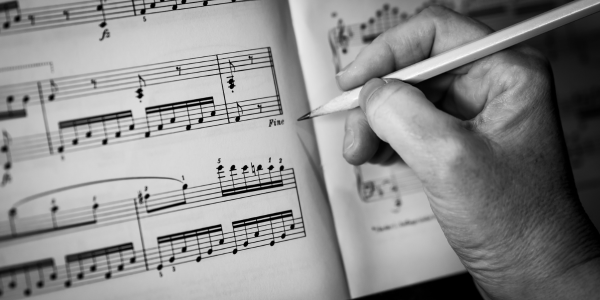We would like to thank Richard Chronister, Mary Ann Letti, and Berdine Ehrman for this insightful article on summer reading activities. To read the full article, click here.

Both writers for this issue’s Music Reading Department take the view that summer is special for piano students. A good case can be made for discontinuing the regular curriculum and making sure that summer study is something that makes the coming autumn a thing to look forward to rather than a thing to dread.
I think that one of the most important aspects of this summer-difference is that the activities mentioned below are inherently reader builders. There is a vast difference between knowing how to read and being able to read fluently. Reading drills which ask students to name notes (saying or writing), to draw intervals, to spell chords, are drills on how to read; they are not drills in actual reading. The only thing that can truly be called a reading drill is reading a piece of music (notes, rhythm, dynamics) and even then, it is reading only if the piece is played in what could realistically be considered a tempo. Reading and playing slowly and carefully is for working out new repertoire; it contributes little to learning to be a fluent reader—unless the slow playing of a passage or piece is instantly followed by faster, in tempo, playing.
Students must read some new music in tempo every week, every day of every week, if they are to become the fluent readers everyone of them is able to become. This, I think, is the most important aspect of the summer programs you will read about here. May I urge you to also include some of these ideas in your year through curriculum. Producing fluent readers remains our second priority, close behind our most important goal—fostering the joy of making music at the piano.
“Gimme a break”
By Mary Ann Lenti
Ah, summer vacation – the very sound of it conjures up images of hammocks, fishing poles, a sandy beach. It means, for teacher and student alike, a welcome change from the activities of our work-a-day year.
“Gimme a break” is the order of the day for using the summer for special reading activities. There are no recitals coming up, no homework for Freddy to rush home to, and no need for a meat and potatoes meal. Here’s a light summer menu of reading activities from which to choose.
POPULAR MUSIC
It is very exciting for children to create, with their own hands, the same soaring melody that lifted E. T. across a moonlit sky. And with the ascent of some fine composers into Hollywood’s elite, there is much music of quality from which to choose.
The editor’s work is crucial here. Some companies throw together the latest hits in what they call “easy piano” format—more often than not, these are plagued by total lack of fingering, narrow margins, minimal space between staves, chords requiring a hand like Rubinstein’s, rhythms requiring a knowledge of calculus, and a texture consisting of unison playing on page one followed by chromatic double thirds and octaves on page three.
To insure success, begin by examining pop collections by your favorite pedagogues. For example, Alfred’s Basic Adult Pop (or Jazz, or Western) Song Piano Book series comes in several levels, and contains clearly printed, logical, and well-fingered arrangements suitable for your 2nd- and 3rd- year younger students as well as your adults.
The Music Pathways series (Carl Fischer) also has a Something Light collection which covers blues, boogie, western, rock, and pop. Again, this is intelligently arranged and edited, and will insure a successful reading experience. There are many other pedagogic collections from which to choose.
If you prefer sheet music of specific student favorites, Bill Boyd’s arrangement for MCA of Somewhere Out There is a good example—clearly printed and fingered, creating a big effect with simple means. There are no big stretches, and no chordal endings to rival The Great Gates of Kiev. Ditto for Felfar Music’s Linus and Lucy.
Piano Duets
As one half of a piano duet team, I have championed the use of duets for reading motivation from coast to coast. Not only does the student have to keep going (since neither wind, nor rain, nor “mess-ups” will stay the teacher from the final cadence), but the student also learns valuable lessons in balance, rhythm, and ensemble.
There are countless volumes of wonderful duets for reading, but my personal favorites are by Diabelli, in which the primo part stays in a five-finger position. Both the Melodious Pieces, Op. 149, and the Pleasures of Youth, Op. 163 yield more dynamism from a stationary position than seems possible. For student motivation, there’s nothing like sounding like a hundred bucks on twenty bucks worth of effort.
We hope you enjoyed this excerpt from Richard Chronister, Mary Ann Letti, and Berdine Ehrman‘s article about reading activities during summer piano lessons. You can read the entire article by clicking here.
MORE ON MUSIC READING
- MAGAZINE ARTICLE: Do You Use Summer Lessons for Special Reading Activities? by Richard Chronister, Mary Ann Letti, and Berdine Ehrman
- MICROCOURSE: Teaching Elementary Technique and Music Reading at the Piano (from The Beginner Course)
- COURSE: The Beginner Course: Establishing Strong Foundations for Young Pianists (Self-Guided)
- MAGAZINE ARTICLE: Why Do You Use the Whole-Keyboard Approach to Beginning Reading? by Richard Chronister, Carol Baughman, Karla Hastings, and Deborah Merrifield
- MAGAZINE ARTICLE: Do You Have Special Ways to Teach Reading to Students With Exceptional Ears? by Richard Chronister, Max Camp, Elaine Clark, Mary Sallee